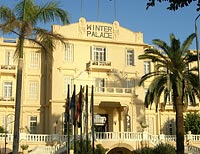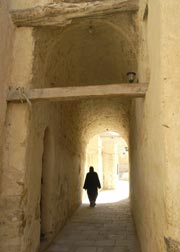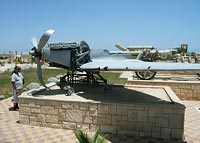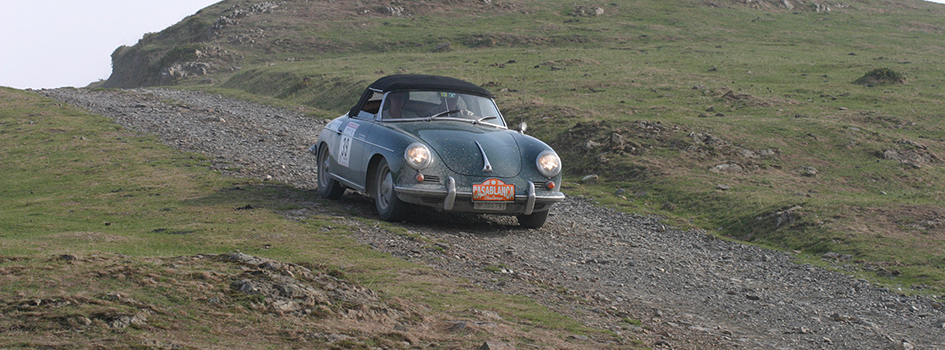DAYS
The Nile Trial 2009
26th January - 9th February 2009
The Nile Trial
The Endurance Rally Association is organising a 15-day rally through Tunisia, Libya and Egypt, Leaving Carthage on January 26th, 2009, and arriving at El Gouna on the Red Sea on February 9th.
The route will be similar in style the Peking to Paris with optional Time-Trials for those seeking a more testing option. For those with a more relaxed approach almost the entire route can be completed on good tarmac roads. The course crosses the Mediterranean to Tunisia, drives through some of the stunning Tunisia countryside via the extensive Roman ruins of Carthage, to the northern border of Libya, and drives the coast-road to Tobruk, Benghazi, and on to Egypt and El Alamein. The route then drives from the Pyramids in Cairo to the Red Sea coast before heading inland to the Nile and Luxor before returning to the exclusive Red Sea resort, El Gouna, for the finish.
It’s a route that will take in many evocative sights brimming with history – remote roads that provide us with a chance to enjoy the company of vintage and classic car enthusiasts with some winter sunshine. Get your time-card stamped in the shadow of the pyramids!
There will be categories for pre-1920 model-types, pre-1941 model-types, and pre-1968 model types, (similar to the Peking to Paris) with medals to be won on optional Time Trials. This is largely touring in nature with competition that is optional – decide on the day if you want to have a bash and win individual medals. The timing and the course is being designed to be practical and feasible for a pre-war car, with rest-stops that place an emphasis on the social side of historic-rallying.
The Nile Trial – Route Survey July 2008
It’s July and the daytime temperature is over 40 degrees here in Luxor on the edge of the Nile. It will be much cooler when the Nile-Trial brings us here from Carthage next February making this event a perfect escape from the cold of a European winter.

As we drink a beer or two in a shaded corner of the Old Winter Palace hotel perhaps it’s a good time to think back over the route that has brought us here.
Most recent in our minds is two days in the frenzy of Cairo. Our time there was spent meeting with the Automobile and Touring Club of Egypt. At an excellent dinner hosted for us by Ramzy Zaklama of the ATCE he was able to tell us of his and the club’s enthusiasm for the event. It is obvious that everything is being done to make the rally welcome on its Egyptian leg.
As we criss-crossed the city from meeting to meeting we quickly learned the driving techniques required to survive but suspect that Nile-Trial competitors will not be sorry that our direct route into and away from our hotel close to the great Pyramids of Giza avoids the city centre. Fortunately rally departure day from Cairo will be on Friday, a non-work day in Egypt, when the roads are very much quieter than normal. After 30kms the city suddenly ends and once more we were on the open road to our lunch halt at a remarkable Monastery nestling in the rugged landscape.
Casting our minds further back it was over two weeks ago when we arrived in Tunis after the ferry crossing from Marseilles. Entering Tunisia much easier than we remember from previous events here with the formalities being quickly completed during the voyage.

Once in Tunisia the next three days were spent bringing together our plans for the Carthage start and on via Kairouan to the Libyan border locating the best roads to challenge the rally minded while offering an easier option for those who might want a gentler approach.
Then came our day to enter Libya. Kim spent a week in Libya earlier in the year but this was our first time arriving by car. With excellent local help we soon had a couple of paperwork anomalies sorted and were on the road with our new number plates attached to the first overnight in Sabratha.
Sabratha, like Leptis Magna, is one of many remarkable historic sites the event will visit, where there will be plenty of time to explore and marvel at what the ancient civilisations created in this part of North Africa.
Onward via Benghazi towards Tobruk and the region where so many famous battles were fought during World War II. Time to reflect in the remarkable dignity of the beautifully maintained Knightsbridge Cemetery near Tobruk.
On a practical note be warned that Libyan drivers are fast and unpredictable. It is not unusual to encounter oncoming traffic on a dual carriageway, and other similar antics, but the standard of alertness seems high and it’s a comfort to know that in this alcohol free country the other driver will not be under the influence, and…. relish the fact that petrol is currently 35-40 pence a GALLON. Without fail the Libyan people we met were friendly and courteous without any inclination to hassle or bother us. Enjoy your Libyan motoring experience.
Finally we reached Egypt to be greeted by new friends bearing essential supplies…. a cool-box full of ice-cold beer.

Not too far to go on the first day in Egypt before reaching Marsa Matrouh and the opportunity of a rest and a cool beer in the comfortable seaside hotel or perhaps a visit to Rommel’s bunker for those that wish to extend the WWII theme. Next day as we approached Alexandria and the well presented WWII museum of El-Alemein we conjure pictures of John Mills and Sylvia Syms in Ice Cold in Alex.
Our second Egyptian day ends where our notes began as we found ourselves in a Cairo traffic jam but with the windscreen view filled by the majestic sight of the Pyramids. We were just making a comparison to the M25 when a small gap opened infront and we were off again. There is nothing to compare with driving in Cairo.
There will be a rest day in Cairo with time to catch up on the laundry or to carry out a little car maintenance. Maybe a visit to the Pyramids or perhaps the Cairo Museum that is bursting with antiquities… the choice will be yours.
Next day it is back to business with a spectacular restart and photo opportunity beside the great Pyramids. This day will end beside the Red Sea before our route returns inland to Luxor, The Valley of the Kings and the romance of the Nile.
We still have another couple of days work to do before completing the route survey and returning to England but it looks as though the Nile-Trial will be a great adventure.
The Nile Trial – Route Itinerary
| Day and Date | Route | Country | Kms | ||
| 24th Jan | Sat | Ferry: Marseille to Tunis | |||
| 25th Jan | Sun | Tunis: Sightseeing and preparation | |||
| Day 1 | 26th Jan | Mon | Carthage to Kairouan | Tunisia | 322 |
| Day 2 | 27th Jan | Tue | Kairouan to Tataouine | Tunisia | 483 |
| Day 3 | 28th Jan | Wed | Tataouine to Sabratha | Tunisia / Libya | 219 |
| Day 4 | 29th Jan | Thu | Sabratha to Misratha | Libya | 304 |
| Day 5 | 30th Jan | Fri | Misratha to Sirt | Libya | 272 |
| Day 6 | 31st Jan | Sat | Sirt to Benghazi | Libya | 573 |
| Day 7 | 1st Feb | Sun | Benghazi to Apollonia | Libya | 271 |
| Day 8 | 2nd Feb | Mon | Apollonia to Tobruk | Libya | 242 |
| Day 9 | 3rd Feb | Tue | Tobruk to Marsa Matruh | Libya / Egypt | 364 |
| Day 10 | 4th Feb | Wed | Marsa Matruh to Cairo | Egypt | 474 |
| Day 11 | 5th Feb | Thu | Cairo – Rest Day and sightseeing | ||
| Day 12 | 6th Feb | Fri | Cairo to Soma Bay | Egypt | 507 |
| Day 13 | 7th Feb | Sat | Soma Bay to Luxor | Egypt | 303 |
| Day 14 | 8th Feb | Sun | Luxor – Rest Day and sightseeing | ||
| Day 15 | 9th Feb | Mon | Luxor to El Gouna | Egypt | 401 |
| 10th Feb | Tue | El Gouna: Prizegiving and homeward preparation | 4735 kms | ||
The Nile Trial – Participants
| Vintage (pre 1941 type cars) | |||
| 1 | David Ayre(GB) / Karen Ayre(GB) | 1907 – Itala 40 | 7433 |
| 2 | Geoffrey Foster-Taylor(GB) / David Daniels(GB) | 1924 – Rolls Royce Silver Ghost | 7428 |
| 3 | Geoffrey Cook(GB) / Linda Cook(GB) | 1926 – Vauxhall 14/40 | 2300 |
| 4 | Marius Winkelman(NL) / Victor Silveira da Conceicao(PT) | 1932 – Plymouth PB3 Coupe | 3214 |
| 5 | Curt Hansson(SE) / Clary Lundin(SE) | 1932 – Chevrolet | 3189 |
| 6 | George Rombouts-Howitt(GB) /Monique Rombouts(B) | 1934 – Aston Martin MKII | 1495 |
| 7 | Mark Robinson(GB) / John Austen(GB) | 1937 – Rolls Royce 25/30 Coupe | 4527 |
| 8 | Philip Lunnon(GB) / Michael Heads(GB) | 1937 – Humber Snipe | 2731 |
| 9 | Harry Hickling(AUS) / Catherine Hickling(AUS) | 1938 – MG SA | 2288 |
| 10 | Paul Merryweather(GB) / Sandra Merryweather(GB) | 1938 – Chevrolet Coupe | 3600 |
| 11 | Michael Cattermole(AUS) / Valerie Cattermole(AUS) | 1938 – Buick 840 | 4064 |
| 12 | Caroline Greenhalgh(GB) / Rosie Gibson(GB) | 1938 – Alvis 4.3 | 4300 |
| 14 | Michael O’Shea(GB) / Sarah O’Shea(IRL) | 1948 – Jaguar 3.5 Litre Saloon | 3500 |
| Classic (pre 1968 type cars) | |||
| 17 | David Spurling(GB) / Rosalind Shallcross(GB) | 1953 – Morgan plus 4 | 2187 |
| 19 | Marc Rollinger(LU) / Viviane Biel(LU) | 1957 – Lancia Aurelia B20GT | 1991 |
| 20 | Matthew Keeler(GB) / John Keeler(GB) | 1959 – Volkswagen Beetle | 1300 |
| 22 | Arnold Denman(GB) / Dorothy Denman(GB) | 1965 – Ford Mustang | 4946 |
| 23 | Bill Bolsover(GB) / Bridget Bolsover(GB) | 1967 – Jaguar E-Type | 4200 |
| 24 | Jean Steinhauser(LU) / Anne Steinhauser-Collard(B) | 1967 – Jaguar MkII | 3800 |
| 25 | Richard Ingham(GB) / Judy Ingham(GB) | 1967 – Volvo 1800S | 1778 |
| 26 | Nigel Freeman(GB) / Richard Dorman(GB) | 1968 – MG Midget | 1250 |
| 27 | Frederick Robinson(GB) / Roy Stephenson(GB) | 1968 – Morris 1800 | 1800 |
| 28 | Michael Wilkinson(AUS) / Anne Wilkinson(AUS) | 1968 – Holden HK | 4200 |
| 29 | Jose Romao de Sousa(PT) / Maria Romao De Sousa(PT) | 1968 – Volvo 142 S | 1993 |
| 30 | Clive Dunster(GB) / Cecilia Agger(GB) | 1968 – Lotus Cortina | 1600 |
| 31 | Nigel Broderick(GB) / Paula Broderick(GB) | 1972 – Datsun 240Z | 2393 |
| 32 | Stephen Hyde(GB) / Janet Lyne(GB) | 1960 – Jaguar MkII | 3800 |
| Special Cars | |||
| 35 | Terence Ward(AUS) / Geoffrey Nicholls(AUS) | 1974 – Mercedes 450 SEL | 4520 |
| 36 | David Miller(GB) / Margaret Miller(GB) | 2003 – Rover Streetwise | 1400 |
| 37 | Roger Allen(AUS) / Maggie Gray(AUS) | 2007 – Nissan Pathfinder | 2500 |
| 38 | Sally McCarthy(GB) / Carole Harvey(GB) | 2004 – Mini Cooper | 1598 |
| 40 | Richard Taylor(USA) / David Pierce(USA) | 1969 – Saab 96 | 1498 |
The Nile Trial – Questions
How long is the event in total?
The route in Tunisia, Libya and Egypt is about 4,800 kilometres. Add another 1,100 kms if you drive from Dover to the ferry in Marseilles so the total is about 6,000 Kms or 3,700 if you prefer it in miles.
How do I get to the start?
We all meet up before the boat sails from Marseilles, but you can hook up with others who are driving across France, drive down with the Organisers, or, put your car on a train – some want to try that – and one or two will be using a car transporter from CARS UK who regularly truck cars to the start of events, and then fly down. France is a free run.
Is the ferry across the Mediterranean included?
Yes. We also organise the hotels and most of the meals each evening, one or two evenings leave you to make your own plans but we suggest some local restaurants…
How do I get my car home?
We work closely with CARS UK, a specialised car transport company, who will ship the cars out of Alexandria in Egypt. That’s a cost of £1,500 if you drive there from the finish (allow a day) or £2,000 if you want to just hand over the keys and carnet and let them truck it to the port for you. You then are free to fly home.
What if I break down?
Our sweep-mechanics drive the route in mobile-workshops and are highly experienced in fettling rally cars in the middle of nowhere… the locals are also pretty good at fixing nuts and bolts.
What about the Carnet de Passage?
We are organising a Group Carnet with the RAC Travel Dept for everyone on the event.
Is the competitive part optional?
Yes, nobody is making you do anything – but we have already dialled in lots of time to see the ancient ruins and local sights as you go, that’s part of the appeal of this route. The off-road Time Trial sections are there for those who want the spice of a bit of competition, and there are awards for these sections – you can miss them out if you prefer.
What are the roads like?
We were surprised at the quality of the tarmac, the roads in the main are very good, particularly in Libya.
